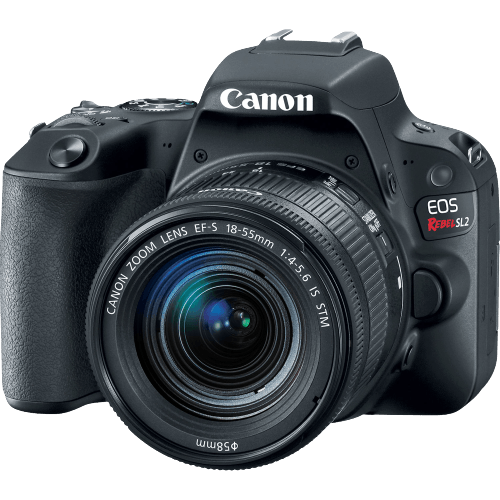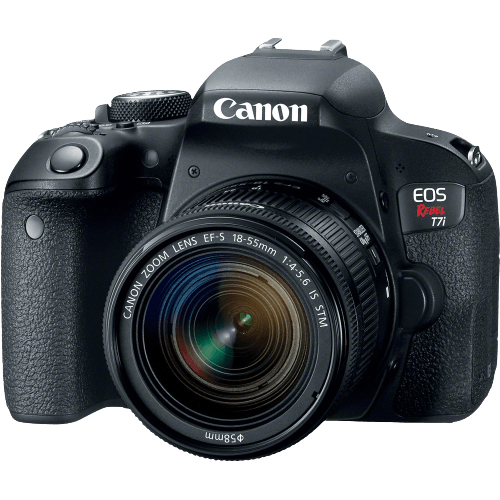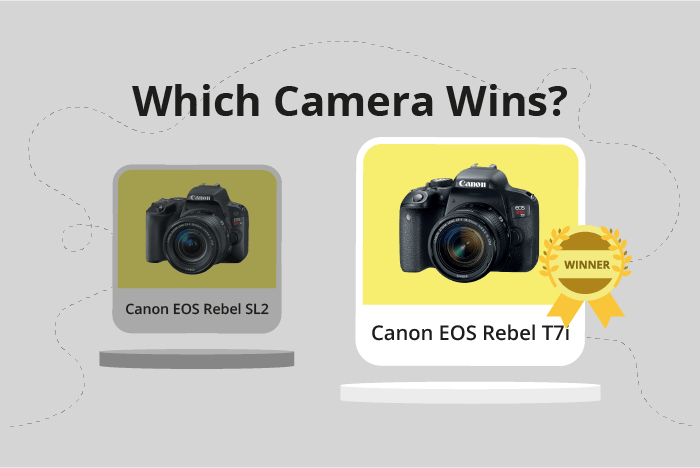Canon EOS Rebel SL2 / 200D vs EOS Rebel T7i / 800D Comparison
Canon EOS Rebel SL2 / 200D

Canon EOS Rebel T7i / 800D

The Canon EOS Rebel T7i / 800D takes the lead with a score of 64/100, while the Canon EOS Rebel SL2 / 200D trails close behind at 62/100. Both cameras are DSLRs released in 2017, with the T7i / 800D announced on February 14th and the SL2 / 200D on June 29th. They share a similar build, with the T7i / 800D sized at 131 x 100 x 76mm and the SL2 / 200D at 122 x 93 x 70mm.
The T7i / 800D offers better performance, justifying its higher launch price of $779 compared to the SL2 / 200D’s $550. However, the SL2 / 200D has an advantage in terms of weight, coming in at a lighter 302g (0.67lbs) compared to the T7i / 800D’s 532g (1.17lbs). This makes the SL2 / 200D more portable and convenient for on-the-go photography.
Considering the specifications, the Canon EOS Rebel T7i / 800D is the superior camera, but the Canon EOS Rebel SL2 / 200D offers a more lightweight option for those prioritizing portability.
Canon EOS Rebel SL2 / 200D vs EOS Rebel T7i / 800D Overview and Optics
The Canon EOS Rebel T7i / 800D wins the optics comparison with a score of 64/100, while the Canon EOS Rebel SL2 / 200D scores 62/100. Both cameras share several specifications: 24.2 and 24 megapixels, CMOS sensor type, Digic 7 processor, a DXOMARK sensor score of 79, APS-C sensor size, Canon lens mounts, and no image stabilization.
The T7i / 800D outperforms the SL2 / 200D in shooting speed, offering 6 frames per second compared to the SL2 / 200D’s 5 frames per second. This advantage allows the T7i / 800D to capture fast-moving subjects more effectively. Additionally, the T7i / 800D features a more versatile lens mount, supporting both Canon EF and EF-S lenses, whereas the SL2 / 200D only supports Canon EF-S lenses. This broader compatibility provides users with a wider selection of lenses to choose from.
On the other hand, the SL2 / 200D has a slight advantage in megapixels, boasting 24.2 compared to the T7i / 800D’s 24. This difference, however, is minimal and unlikely to impact image quality in a significant way.
In terms of optics, the Canon EOS Rebel T7i / 800D is the superior camera due to its faster shooting speed and broader lens compatibility. The Canon EOS Rebel SL2 / 200D, while offering a marginally higher megapixel count, falls short in other key areas. Users seeking a camera with better optics performance should opt for the T7i / 800D.
Canon EOS Rebel SL2 / 200D vs EOS Rebel T7i / 800D Video Performance
The Canon EOS Rebel SL2 / 200D and the Canon EOS Rebel T7i / 800D both have a video score of 70/100. This means that neither camera has a clear advantage in terms of video capabilities. Both cameras share several key video specifications, such as Full HD max video resolution, max video dimensions of 1920 x 1080, and a max video frame rate of 60fps. Additionally, both cameras have built-in time-lapse functionality.
Since both cameras have the same video score and share many video specifications, it is difficult to determine a clear winner in terms of video capabilities. However, there may be other factors to consider that could make one camera more suitable for specific needs or preferences.
The Canon EOS Rebel SL2 / 200D may have some advantages over the T7i / 800D in terms of size and weight, making it more portable and convenient for on-the-go shooting. However, this advantage does not directly impact video quality or performance.
On the other hand, the Canon EOS Rebel T7i / 800D may offer additional features or improved performance in other areas, such as autofocus or image quality, which could make it a more attractive option for some users. Again, these advantages do not directly affect the video capabilities of the camera.
Given that both cameras have the same video score and share many key video specifications, it is not possible to declare a definitive winner in terms of video capabilities. Users should consider other factors, such as size, weight, and additional features, to determine which camera best suits their specific needs and preferences.
Canon EOS Rebel SL2 / 200D vs EOS Rebel T7i / 800D Features and Benefits
The Canon EOS Rebel SL2 / 200D and the Canon EOS Rebel T7i / 800D both have a feature score of 70/100. This indicates that the two cameras are evenly matched in terms of their features.
Both cameras share several specifications, such as a 3-inch screen size, a screen resolution of 1,040,000 dots, a touchscreen, a flip screen, WIFI, and Bluetooth. These common features provide users with a similar experience in terms of usability and connectivity.
The Canon EOS Rebel T7i / 800D, however, has an advantage in one area: GPS. This feature allows users to geotag their photos, making it easier to organize and locate images based on the location where they were taken. This added functionality gives the T7i / 800D an edge over the SL2 / 200D.
On the other hand, the Canon EOS Rebel SL2 / 200D does not possess any additional features that make it superior to the T7i / 800D. Both cameras have the same feature score and share most specifications, making them highly comparable in terms of their features.
Taking these factors into account, the Canon EOS Rebel T7i / 800D is considered to be a slightly better option due to its GPS feature. However, the Canon EOS Rebel SL2 / 200D remains a strong competitor, as it shares many of the same specifications as the T7i / 800D. Users should consider their specific needs and preferences when choosing between these two cameras, as both provide a similar experience in terms of features and usability.
Canon EOS Rebel SL2 / 200D vs EOS Rebel T7i / 800D Storage and Battery
The Canon EOS Rebel SL2 / 200D wins the storage and battery comparison with a score of 32/100, while the Canon EOS Rebel T7i / 800D scores 29/100. Both cameras have one memory card slot, accepting SD, SDHC, and SDXC cards (UHS-I compatible). They also use the same battery type, LP-E17, and neither offers USB charging.
The SL2 / 200D outperforms the T7i / 800D in battery life, providing 650 shots per charge compared to the T7i / 800D’s 600 shots. This difference makes the SL2 / 200D more suitable for extended shooting sessions without needing to replace or recharge the battery.
There are no areas where the T7i / 800D surpasses the SL2 / 200D in terms of storage and battery. The SL2 / 200D’s longer battery life gives it a clear advantage over the T7i / 800D in this category, making it the better choice for photographers prioritizing longer shooting times.
Alternatives to the Canon EOS Rebel SL2 / 200D and EOS Rebel T7i / 800D
Are you still undecided about which camera is right for you? Have a look at these popular comparisons that feature the Canon EOS Rebel SL2 / 200D or the Canon EOS Rebel T7i / 800D:

